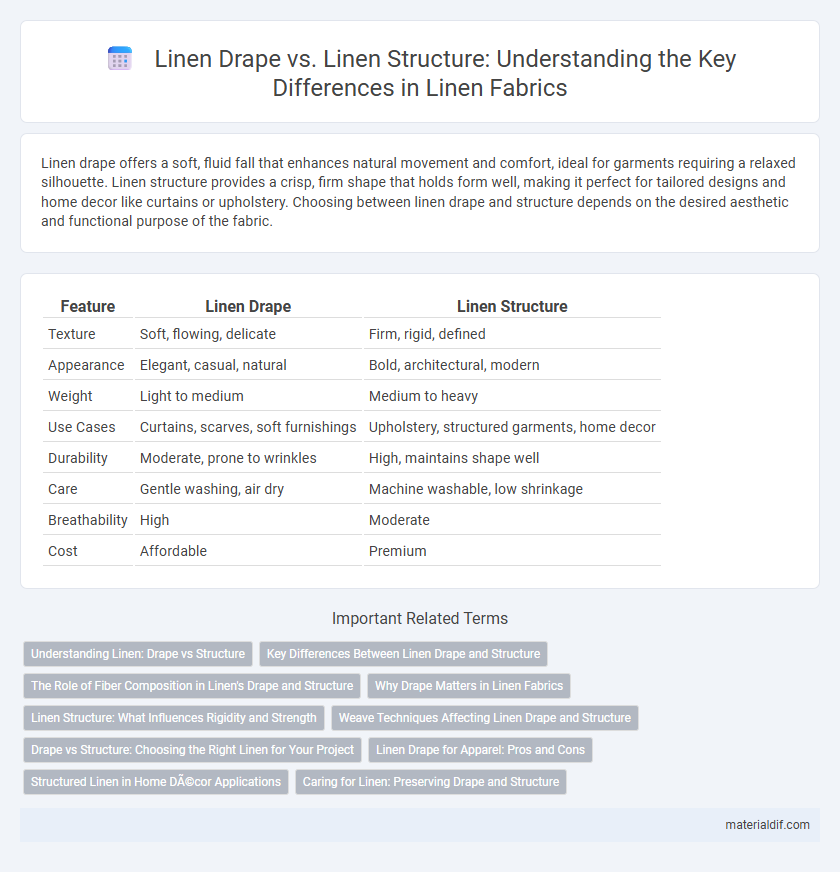Linen drape offers a soft, fluid fall that enhances natural movement and comfort, ideal for garments requiring a relaxed silhouette. Linen structure provides a crisp, firm shape that holds form well, making it perfect for tailored designs and home decor like curtains or upholstery. Choosing between linen drape and structure depends on the desired aesthetic and functional purpose of the fabric.
Table of Comparison
| Feature | Linen Drape | Linen Structure |
|---|---|---|
| Texture | Soft, flowing, delicate | Firm, rigid, defined |
| Appearance | Elegant, casual, natural | Bold, architectural, modern |
| Weight | Light to medium | Medium to heavy |
| Use Cases | Curtains, scarves, soft furnishings | Upholstery, structured garments, home decor |
| Durability | Moderate, prone to wrinkles | High, maintains shape well |
| Care | Gentle washing, air dry | Machine washable, low shrinkage |
| Breathability | High | Moderate |
| Cost | Affordable | Premium |
Understanding Linen: Drape vs Structure
Linen drape refers to the fabric's natural fluidity and softness, allowing it to hang smoothly with gentle folds, ideal for garments that require a breathable, relaxed fit. Linen structure highlights the fabric's inherent stiffness and crispness, which gives garments a more defined silhouette and durability, making it suitable for tailored clothing or home textiles. Understanding the balance between linen's drape and structure is essential for selecting the right fabric weight and weave for specific design needs or functional purposes.
Key Differences Between Linen Drape and Structure
Linen drape exhibits a soft, fluid quality that enhances its natural breathability and lightweight feel, making it ideal for garments requiring movement and elegance. Linen structure, on the other hand, emphasizes a firmer, more rigid form, providing durability and shape retention suitable for tailored or architectural designs. These key differences underline linen's versatility, balancing aesthetic flow with functional support.
The Role of Fiber Composition in Linen's Drape and Structure
Linen's fiber composition, primarily flax fibers, plays a crucial role in determining its drape and structure, offering natural stiffness that enhances fabric body. The lumen, or central core of flax fibers, provides resilience and durability, contributing to linen's characteristic crispness and structural integrity. Variations in fiber length and fineness affect the fabric's flow and pliability, influencing whether linen exhibits a soft drape or a more rigid form.
Why Drape Matters in Linen Fabrics
Linen drape significantly influences the fabric's appearance and comfort, creating a soft, fluid silhouette that enhances wearability and aesthetic appeal. Linen with natural drape adapts well to body movement and provides breathability, making it ideal for garments requiring flexibility and elegance. In contrast, structured linen offers rigidity and form, suitable for tailored styles but less effective in delivering the relaxed, breathable qualities that define linen's unique charm.
Linen Structure: What Influences Rigidity and Strength
Linen structure is primarily influenced by fiber quality, weave density, and yarn thickness, which together determine the fabric's rigidity and strength. High-quality flax fibers contribute to greater tensile strength, while tighter weaves increase durability and resistance to deformation. Yarn thickness also affects rigidity, with thicker yarns providing a stiffer, more robust fabric ideal for structured applications.
Weave Techniques Affecting Linen Drape and Structure
Linen drape is influenced by weave techniques that create a soft, fluid texture, such as plain or twill weaves that allow fabric to fall gracefully and conform to shapes. In contrast, linen structure depends on tighter, denser weaves like herringbone or basket weaves, which enhance stiffness and durability, providing more rigidity and form retention. The choice of weave directly impacts linen's aesthetic and functional properties, balancing between a flowing drape and a firm structure.
Drape vs Structure: Choosing the Right Linen for Your Project
Linen drape offers a soft, flowing texture ideal for garments and home textiles requiring flexibility and movement, while linen structure provides a crisp, firm quality suited for tailored clothing and upholstery. Selecting the right linen depends on whether your project demands fluidity or stability, as drape linens excel in elegance and comfort, whereas structured linens ensure durability and defined shapes. Understanding the fiber weave and weight helps in choosing between the breathable, lightweight drape and the heavier, supportive structure for optimal performance.
Linen Drape for Apparel: Pros and Cons
Linen drape in apparel offers a natural, breathable fabric that falls softly, enhancing garment fluidity and comfort, ideal for warm-weather clothing. The primary advantage lies in its lightweight, moisture-wicking properties, promoting durability and ease of care, while a notable downside is its tendency to wrinkle easily, affecting the garment's polished appearance. Linen drape's texture and natural luster contribute to a casual yet elegant look, making it a preferred choice over linen structure fabrics, which are stiffer and better suited for formal or tailored applications.
Structured Linen in Home Décor Applications
Structured linen in home decor offers a refined aesthetic with its ability to hold shape and provide crisp lines, making it ideal for upholstery, tailored curtains, and accent pillows. Its durability and natural texture enhance both functionality and visual appeal, contributing to a sophisticated, yet organic atmosphere in living spaces. Unlike draped linen, structured linen maintains form and adds architectural interest, elevating interior design with subtle texture and strength.
Caring for Linen: Preserving Drape and Structure
Caring for linen requires distinct approaches to preserve its drape and structure effectively. To maintain a linen drape's softness and fluidity, gentle washing in cold water and air drying on a flat surface prevents stiffness and fabric distortion. For linen structure, reinforcing the fabric's crispness involves precise ironing with steam on medium heat and storing items flat to avoid creases that compromise the garment's shape.
Linen Drape vs Linen Structure Infographic

 materialdif.com
materialdif.com